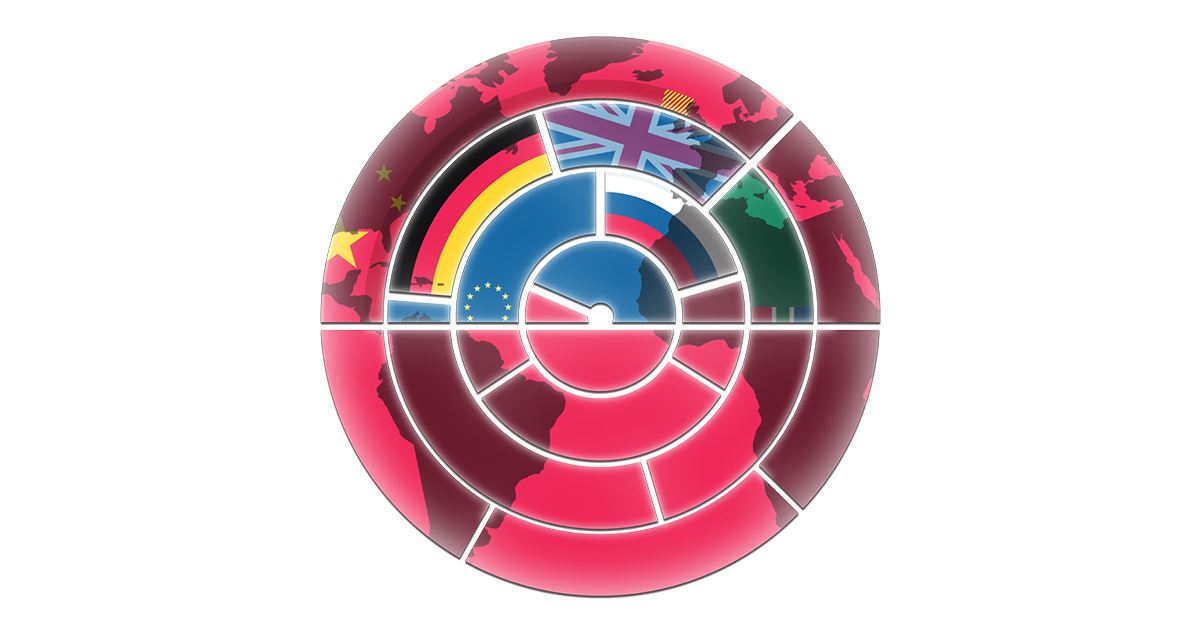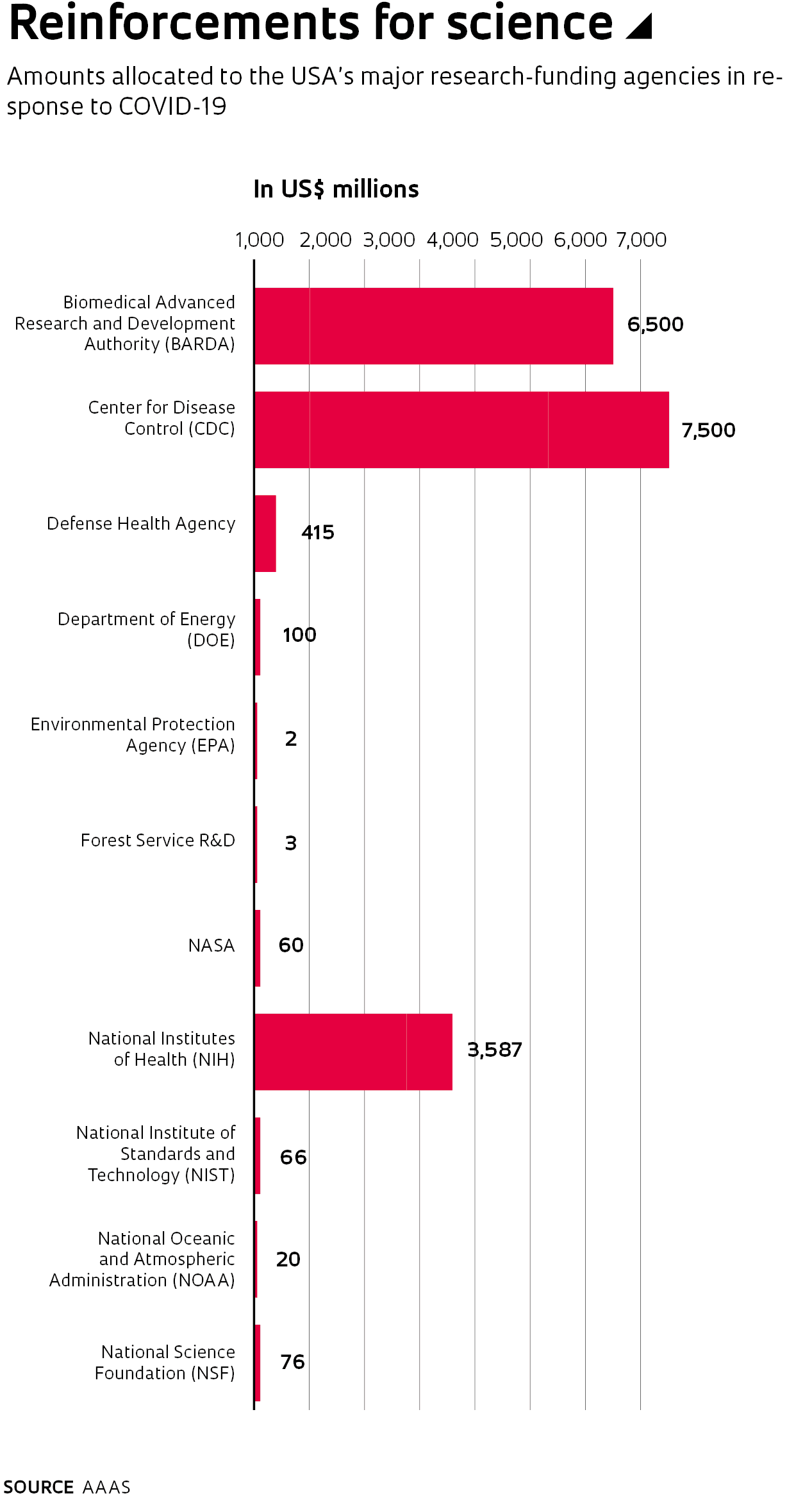Many countries have significantly increased public spending to mitigate the effects of the pandemic, but the impact on funding for COVID-19 research has varied. While wealthier nations have managed to invest heavily in testing drugs and vaccines, developing countries have spent less on studying the disease, and in some cases have even made cuts to their science, technology, and innovation budgets in response to recessions caused by the pandemic.
After a 9% cut, China will have a federal budget for science and technology of US$45 billion. But the country’s Research and Development investments are expected to grow by 3% compared to 2019, with added resources from provinces
The most ambitious strategy was adopted by the USA. Four major economic packages, amounting to trillions of dollars, have already been approved to mitigate the impacts of the novel coronavirus. Some of this money was incorporated into the budgets of the country’s major funding agencies, such as the Biomedical Advanced Research and Development Authority (BARDA), a division of the Department of Health and Human Services. The agency has already received an injection of US$6.5 billion, 10 times greater than its total 2019 budget of US$561 million. The National Institutes of Health (NIH) has so far received nearly US$3.6 billion. Of this total, US$950 million is being used to fund the development of a COVID-19 vaccine in partnership with US pharmaceutical company Moderna. “Funding is based entirely on increasing public debt,” Matthew Hourihan, director of the Research and Development Budget and Policy Program at the American Association for the Advancement of Science (AAAS), told Pesquisa FAPESP. “This is new money, not previously expected.”
The additional budget has also enabled the National Science Foundation (NSF), which funds basic research, to accelerate its analysis of proposals for research on the novel coronavirus. The agency has so far received US$76 million for Rapid Response Research, a mechanism used in emergency situations to fund studies with budgets of up to US$200,000. Even agencies like NASA and the National Oceanic and Atmospheric Administration (NOAA) have been awarded extra money to fund operations during the health crisis.
– Times of uncertainty
– Health professionals under emotional stress
– The puzzle of immunity
– The risk of traveling by plane
– Sharing and expanding knowledge
– Pandemics as allegory
While American agencies saw their budgets increased, those in South Africa, which has the largest scientific output in Africa, are suffering cuts to compensate for the effects of the country’s economic difficulties. The country had already entered a recession in the second half of 2019. In June, the government announced a 20% reduction in the 2020–2021 budget for all federal agencies and departments. The following month, Blade Nzimande, Minister of Higher Education, Science, and Technology, announced that he had managed to reduce the cut to 8%, equivalent to roughly US$600 million.
In Germany, the Ministry of Education and Research has been given €160 million to fight the pandemic, of which €145 million are for health innovation
The National Research Foundation (NRF) and the Council for Scientific and Industrial Research will suffer the biggest cuts, at around US$5.7 million each. The Technological Innovation Agency will lose US$2.7 million, the Human Sciences Research Council US$1.9 million, and the South African National Space Agency US$1 million. The NRF will lose 19% for scholarships and 32% for its Centers of Excellence in South Africa program. The opposition party, the Democratic Alliance, is trying to reverse the cuts in Parliament. “Nearly 5,000 students will not be funded. That is a lot of postgraduate students and careers not happening,” said Belinda Bozzoli, shadow minister of higher education, science, and technology, at a meeting on July 15.
The economic contraction and a reluctance to further increase public debt have led several governments to review their budgets. China was one of them, but it made sure to do so in a way that does not compromise innovation, which is seen as crucial to the resumption of growth. As the first country to suffer from COVID-19, China’s Gross Domestic Product (GDP) fell by 6.8% in the first quarter of this year. In May, the Chinese Ministry of Finance announced a 9.1% cut in federal science and technology spending in 2020. According to the new budget, federal spending in the sector will be 320 billion yuan, equivalent to US$45 billion.
During the pandemic, the European Union approved an €81 billion budget for Horizon Europe, its main research and innovation program. The amount, to be invested over seven years, is €13.5 billion lower than the one proposed two months ago
The central government has determined, however, that the total investment in research and development (R&D) in 2020 will be 3% higher than last year, with provincial governments responsible for the increases. Not every province has been negatively affected by the pandemic. Zhejiang, a coastal province with 57 million inhabitants, for example, experienced economic growth in the first quarter of 2020 thanks to the performance of internet companies and medical equipment manufacturers. Research into the novel coronavirus is privately funded in China. Development of the CoronaVac vaccine by Sinovac Biotech was made possible by two investment firms, Advantech Capital and Vivo Capital, both of which invested US$7.5 million in Sinovac. The vaccine is being trialed in Brazil in partnership with the Butantan Institute in São Paulo. The federal cuts are the first in an upward trend that has lasted three decades. Last year, China invested 2.17 trillion yuan in R&D, three times more than in 2010.
Regular investment is a key factor in maintaining the vitality of research systems. The scientific community in the state of São Paulo benefits from stable funding thanks to a clause in the 1989 state constitution requiring that 1% of the state’s tax revenue be allocated by FAPESP for use in scientific and technological development. Despite facing economic crises and tax revenue fluctuations, the Foundation’s annual disbursement has remained above one billion reais in every year of the past decade—in 2018, it invested R$1.22 billion. This stability also extends to São Paulo’s three state universities, which have administrative and financial autonomy and receive 9.57% of the total collected via state taxes on goods and services (ICMS). This robust system guarantees not only research security, but also quick responses to extreme situations, such as the current pandemic.
The United Kingdom has given an additional US$38.3 million for COVID-19 research and US$12.8 million for diagnostic testing
Such continuity is not guaranteed across Latin America. The pandemic has occurred at a time when most countries in the region are still recovering from the global financial crisis, with reduced levels of investment in research compared to beforehand. In an online seminar held in May, Alicia Bárcena, executive secretary of the Economic Commission for Latin America and the Caribbean (ECLAC), drew attention to the low levels of spending on science in the region. The average amount invested in R&D is 0.7% of regional GDP, something she says requires careful management in the midst of the current health crisis. “The challenge is to bridge the gap between productive sectors and science, technology, and innovation,” said Bárcena, referring to the need to manufacture medical supplies, personal protective equipment, and mechanical ventilators.
In 2020, the Brazilian Ministry of Science, Technology, and Innovation (MCTI) had its lowest budget in over a decade—not including salaries and mandatory expenses, R$3.7 billion was invested, 30% less than in 2019. In May, two provisional measures were created to allocate additional resources to the battle against COVID-19, providing R$326 million from the National Fund for Scientific and Technological Development (FNDCT). According to the Institute for Applied Economic Research (IPEA), approximately R$70 million of this amount has already been spent. Mexico is in a similar situation. In 2019, the country’s National Council of Science and Technology (CONACYT), which issues research grants and oversees 27 research centers, saw its budget reduced by 9% compared to the previous year. In 2020, it was increased by 3.4%. The extra investment includes US$1.17 million to develop and test a vaccine. Argentina has already added 55 billion pesos to its budget, equivalent to US$760 million, to fight the novel coronavirus. About US$5 million was spent on a call for research projects related to the virus. In 2018, Argentina invested 0.6% of its GDP in R&D (compared to 0.4% in Mexico and 1.3% in Brazil).
Russia has added 1.5 billion rubles—about US$20 million—to the budget of the Federal Service for the Oversight of Consumer Protection and Welfare, its front-line agency in the fight against COVID-19
At a time when so many countries are experiencing severe recessions, with high unemployment and healthcare costs, the demand to spend more on COVID-19 research is often questioned, even in developed nations. At the end of July, the leaders of the 27 member states of the European Union approved its budget for the next seven years, which includes investments of €1.8 trillion: €1.07 trillion for regular spending and €750 billion for a post-pandemic economic recovery fund. Of the total budget, €81 billion will be allocated to Horizonte Europa, the bloc’s main research and innovation program—€13.5 billion less than the amount discussed two months ago. “These cuts are a major disappointment and a breach of trust, given European politicians’ rhetoric on the importance of research,” Belgian lawyer Kurt Deketelaere, secretary-general of the League of European Research Universities, told the journal Science. Only €5 billion of the recovery fund—0.66% of the total—will go to scientific projects. Disregarding this amount, the Horizonte Europa budget will be the same size as its predecessor, Horizon 2020, which operated from 2014 until this year.

